Okonomiyaki is a Japanese savory cabbage pancake that's super popular amongst Japanese street food. It's dressed with a variety of toppings, all to your preference, from meats to sauce and condiments. This Okonomiyaki recipe is an adaptation of the traditional Osaka style Okonomiyaki with some of our own twists.
Recently, Kyong introduced me to Okonomiyaki, and I instantly fell in love! Not only is the name fun to say, it's also a dish catered to exactly how YOU like it!
Okonomiyaki is a popular street food in Japan, and I can totally understand why. These pancakes are filled with thin cut cabbage that's just cooked while maintaining some refreshing crunch, pieces of Chinese sausage providing some extra umami, sweetness and saltiness, and bacon to top it all off. I could literally eat it as is, but you have to try it with a few drizzle of Okonomiyaki sauce and spicy mayo to give it a few extra layers of flavor. And did I mention that these Japanese savory cabbage pancakes are super-duper easy to make? Because they are!
Now, let's dive into some Okonomiyaki tips and FAQs!
What is Okonomiyaki [Oh-koh-no-mee-ya-kee]?
Okonomiyaki is one of Japan's most popular street food. It's a pan-seared savory cabbage pancake that can be topped with a variety of ingredients you'd like. Hence, "okonomi" literally translates as "to one's liking/ preference." Its main components are flour, eggs, dashi, cabbage, and your choice of proteins and toppings.
Osaka style vs. Hiroshima style Okonomiyaki
Like many other foods, there are different styles of Okonomiyaki. For the most part, there are two distinct versions, Osaka and Hiroshima style.
The main difference between the two is that, the Osaka version mixes the batter with all the ingredients along with finely chopped cabbage. While, the Hiroshima ones have thin crepe-like pancakes that sandwich layers of thinly shredded cabbage and toppings, which always includes either udon or yakisoba noodles.
We found that we prefer the Osaka version more because it's more pancake-y to us. So our adaptation of okonomiyaki is based off the Osaka style, but with shredded cabbage and some twist of our own.
What can I add to my Okonomiyaki?
Besides the cabbage, because it is a savory cabbage pancake, you can add almost anything to the mix. Some popular additions are chicken, pork, shrimp, octopus, green onions, and other vegetables.
For us, we like to add green onion and small pieces of Chinese style sausage (bai you chang-白油肠) to add some sweet and saltiness. We also like to arrange slices of thin-cut bacon on our pancakes...cuz who doesn't like bacon? Lol.

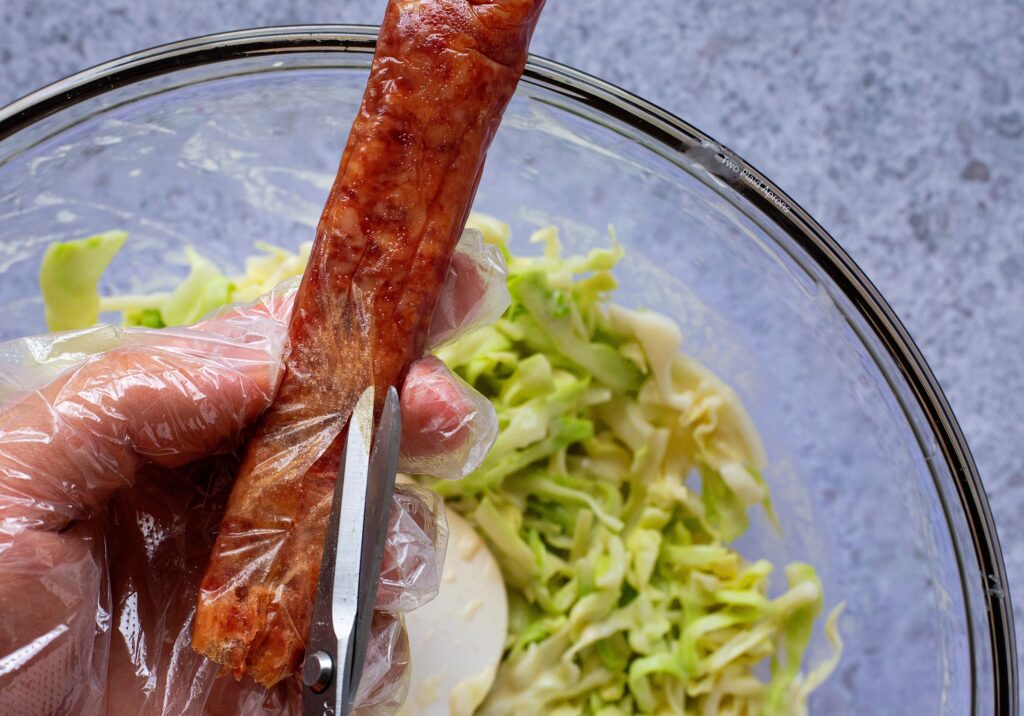
What is dashi? And do I need dashi to make Okonomiyaki?
Dashi is simply a Japanese term for broth/ stock, mainly ones made of kelp and dried fish or anchovies. It's very common in Japanese savory cooking to substitute dashi for water to make dishes more flavorful.
We recommend that you use dashi for your okonomiyaki because it does impart extra flavor. However, it is not necessary, so you can substitute it for water with no issue. If you want to use dashi, you can usually find dashi powder/ base at your local Asian market. The most popular and common brand is "Ajinomoto" HonDashi.
To make dashi from scratch (makes about ⅔ cup):
You need:
- ¾ cup of water
- 3 inch square of kombu or 2-3 pieces of dry kelp
- 3 medium size dry anchovies or 4-5 small anchovies (You can keep these frozen in an airtight container.)
- 2-3 pieces of dry shiitake mushrooms (optional)
- 2.5 grams/ .05 ounce of bonito flakes (a very generous pinch)
Combine water and everything else, except bonito flakes, into a small saucepan. Bring it to a boil then turn off the heat. Discard the kombu/ kelp*, anchovies, and mushrooms. Add the bonito flakes to the hot stock and let it steep for 5-10 minutes. Strain the dashi and discard the bonito*. You can use the dashi immediately or refrigerate it up to 5 days or freeze it for 2 months.
*The used kombu/ kelp and the strained bonito can be saved to make homemade furikake. Keep reading for further instructions below. Instructions will also be in the recipe card.*
How much batter do I need for my Okonomiyaki?
This Okonomiyaki recipe has just enough batter to coat everything and keep all the ingredients adhered. That is just our preference. We are here for the cabbage and the added toppings! But of course, if you prefer, you can absolutely make extra batter for your Okonomiyaki.
What does Okonomiyaki sauce taste like? What can I use it for?
Okonomiyaki sauce kind of tastes like a sweet and tangy steak sauce. It's a basic Japanese condiment that's super versatile and can be used for pretty much anything. Most commonly it is, of course, used for Okonomiyaki but you can most definitely use it in place takoyaki sauce, for your tonkasu, meats and burgers, or even as a marinade.
To make a basic Okonomiyaki sauce:
Whisk together ¼ cup of ketchup, 2 ½ Tablespoons of Worcestershire sauce, 2 Tablespoons of oyster sauce, and 2 Tablespoon of granulated sugar.
You can always adjust the sweetness, tanginess, and flavors to this basic recipe to your liking.
What can I garnish my Okonomiyaki pancakes with?
The traditional and most simple way of garnishing your Okonomiyaki is by topping it with some dried bonito flakes. But you can totally upgrade it by adding some pickled red ginger and furikake!
Pickled red ginger is a classic garnish and topping for many Japanese street snacks, like in okonomiyaki and takoyaki. It's make by pickling ginger in red plum vinegar, which is a specialty item that we can't get everywhere. And because of that, pickled red ginger is hard to come by for us. Luckily, we found that those pink sushi gingers are pretty good substitutes.
As for furikake, there are many different flavors to pick from. The most popular ones being just nori (seaweed) and sesame seed or the ones with the addition of dried fish/ bonito. If you've ever purchased furikake before, I'm sure you've notice how expensive it is for just a tiny 1.7 ounce bottle. Yeah...super expensive, but guess what?! It's really easy to make, especially if you're already making homemade dashi.
To make homemade furikake:
You need:
- the used kombu/ kelp and bonito from your dashi (thinly slice the kombu/ kelp)
- a few drops of soy sauce (literally, just a few drops)
- pinch of salt and sugar
- seaweed snacks (optional)
- toasted black or white sesame seeds, or both (optional)
Add the sliced kombu/ kelp and bonito, soy sauce, salt, and sugar to a medium non-stick pan over medium low heat. Toast the kombu-bonito mixture until dry and crackly while stirring it occasionally. When the kombu/ kelp is dry and crackly, transfer the mix to a plate lined with paper towel to let cool. Once cooled, crumble the dried kombu/ kelp and bonito into small pieces with your fingers. Break the snack seaweed into small pieces with your fingers or scissors and add it to the furikake mix along with the toasted sesame seeds. Use immediately or transfer your homemade furikake into an airtight container and store in a cool, dry place for up to 2 weeks.
If you're looking for other easy Asian dishes, you may like these:
- Sweet Potato Mochi Pancakes (Hotteok - 호떡)
- Jiggly Japanese Soufflé Pancakes
- Baked Orange Cauliflower "Chicken"
- Creamy Peanut Butter Miso Ramen
Cook with love,
Mei ❤️
If you’ve made this recipe or any recipe from our blog, please tag us on Instagram @twoplaidparons! We would love to see your creations! It absolutely makes our day! 🥰
📖 Recipe
Okonomiyaki - Savory Japanese Cabbage Pancakes
Ingredients
For the okonomiyaki sauce:
- ¼ cup ketchup
- 2½ Tablespoon Worcestershire sauce
- 2 Tablespoon oyster sauce
- 2 Tablespoon granulated sugar
For the spicy mayo:
- ½ cup mayonnaise
- 2 Tablespoon Sriracha
For the okonomiyaki (cabbage pancake)
- ½ cup all-purpose flour
- 1 large egg
- ⅔ cup hondashi powder (or water)
- 2 Tablespoon oil (plus more for cooking)
- ½ teaspoon salt
- ¼ head cabbage, thinly shredded (about 6-8 ounces)
- 1 stalk green onion, sliced
- 3 Tablespoon tempura bits or panko (optional)
- 1 stick Chinese sausage (optional)
- 3 slice thin-cut bacon, cut each into ⅓ pieces (optional)
Optional: garnishes
- Bonito flakes
- Furikake
- Pickled red ginger (or sushi ginger)
Optional: Homemade dashi:
- ¾ cup water
- 1 3 inch piece kombu (or 3-4 pieces of dry kelp)
- 3 medium dry anchovies (or 4-5 small ones)
- 2-3 pieces dried shiitake mushrooms
- 2.5 grams bonito flakes (or a very generous pinch)
Optional: Homemade furikake
- Strained kombu and bonito flakes from dashi
- Soy sauce
- Pinch of salt & sugar
- 2 sheet seaweed snack
- Toasted sesame seed (black, white, or both)
Instructions
For the sauces:
- For both the okonomiyaki sauce and spicy mayo, combine all of its ingredients in a bowl and mix until thoroughly combined. Transfer each sauce into either a pipping bag or squeeze bottle for extra convenience.
Optional: Homemade Dashi
- In a small saucepan, combine water, kombu/ kelp, dry anchovies, and dry shiitake mushrooms. Over hight heat, bring it to a boil and immediately turn off the heat. Remove the kombu, anchovies, and shiitakes.Stir in the bonito flakes into the hot stock and let steep for 5-10 minutes. Strain the bonito flakes from the dashi. Set aside until needed*.
Optional: Homemade furikake
- Thinly slice the kombu used in the dashi. Add the sliced kombu, the used bonito, a few drops of soy sauce, a pinch of salt and sugar to a medium size non-stick pan over medium low heat. Toast the furikake until the sliced kombu becomes dry, crackly, and crispy while stirring every so often.Transfer the furikake onto a plate lined with paper towel to cool. Break up the dried kombu and bonito with your fingers. Cut or break seaweed snacks into small pieces and add it to your furikake along with toasted sesame seeds. Use immediately or store it in an airtight container in a cool, dry place.
For the Okonomiyaki:
- In a large bowl whisk together flour, egg, dashi, oil, and salt until the batter is just smooth. Don't overmix it!Add the thinly shredded cabbage, sliced green onions, and tempura bits or panko.Remove the Chinese sausage from its casing and break the sausage into small bits and pieces. Add it into the batter and fold all of it together until everything is evenly coated in batter.
- Brush a non-stick pan (or griddle) with a small amount of oil, heating eat at medium heat.Scoop ⅓ of the batter onto the pan. Gently flatten the mound of batter to about ¾ - 1 inch thick and try to keep the pancake as circular as possible. The pancake will become flatter as it cooks.Arrange 3 pieces of thin-cut bacon onto the pancake and let the pancake cook until golden brown, about 3-4 minutes. Carefully flip the pancake and cook the bacon side until golden brown and the bacon is crispy, about 4-5 minutes. Transfer pancake to a plate.Repeat with remaining batter
- Garnish the pancake with both sauces, furikake, red ginger (or sushi ginger), and bonito flakes.
- Enjoy the pancakes while they're hot!




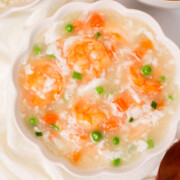



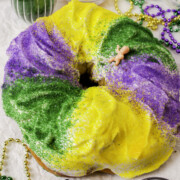


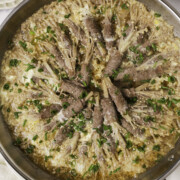


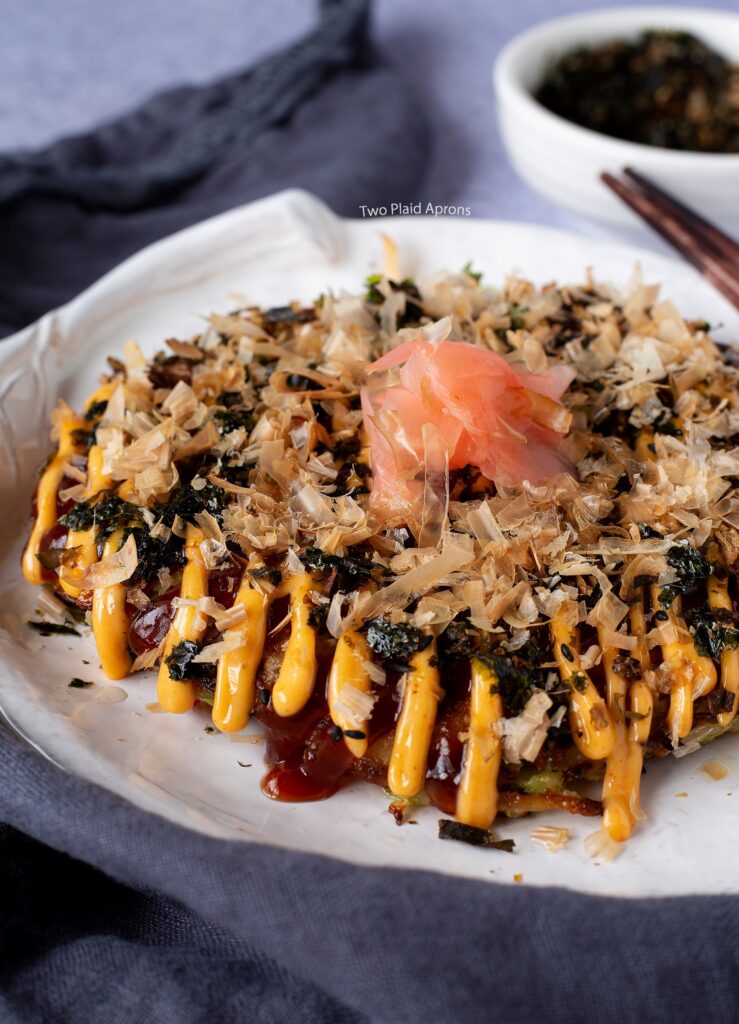





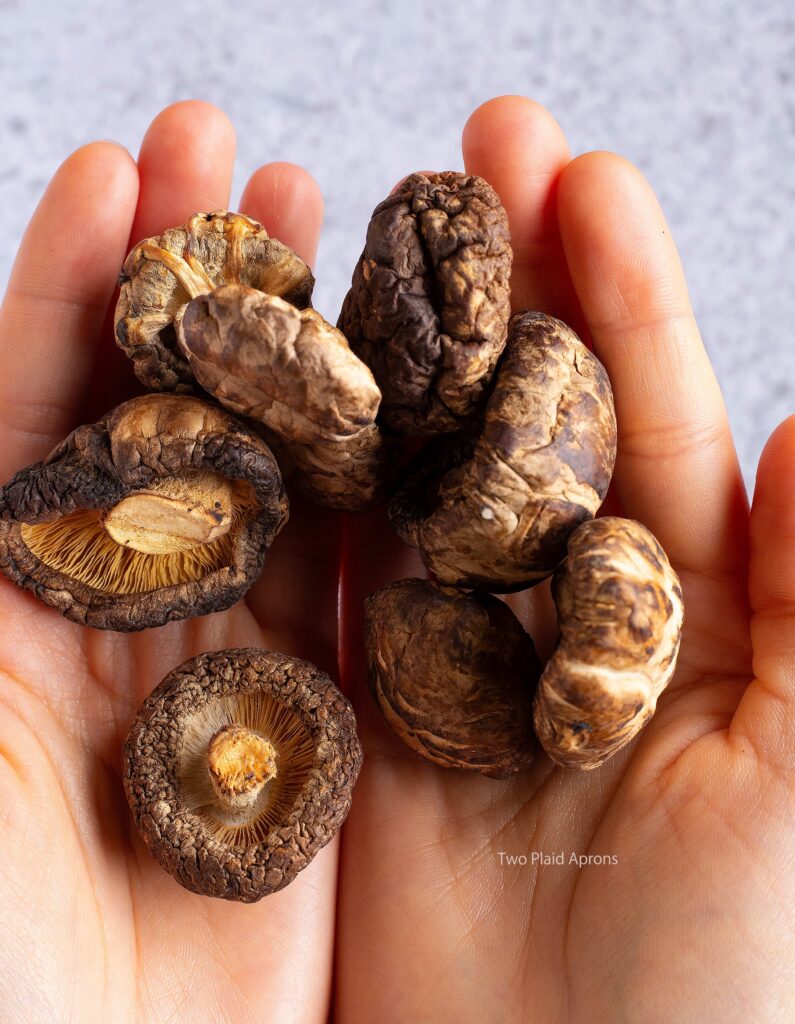








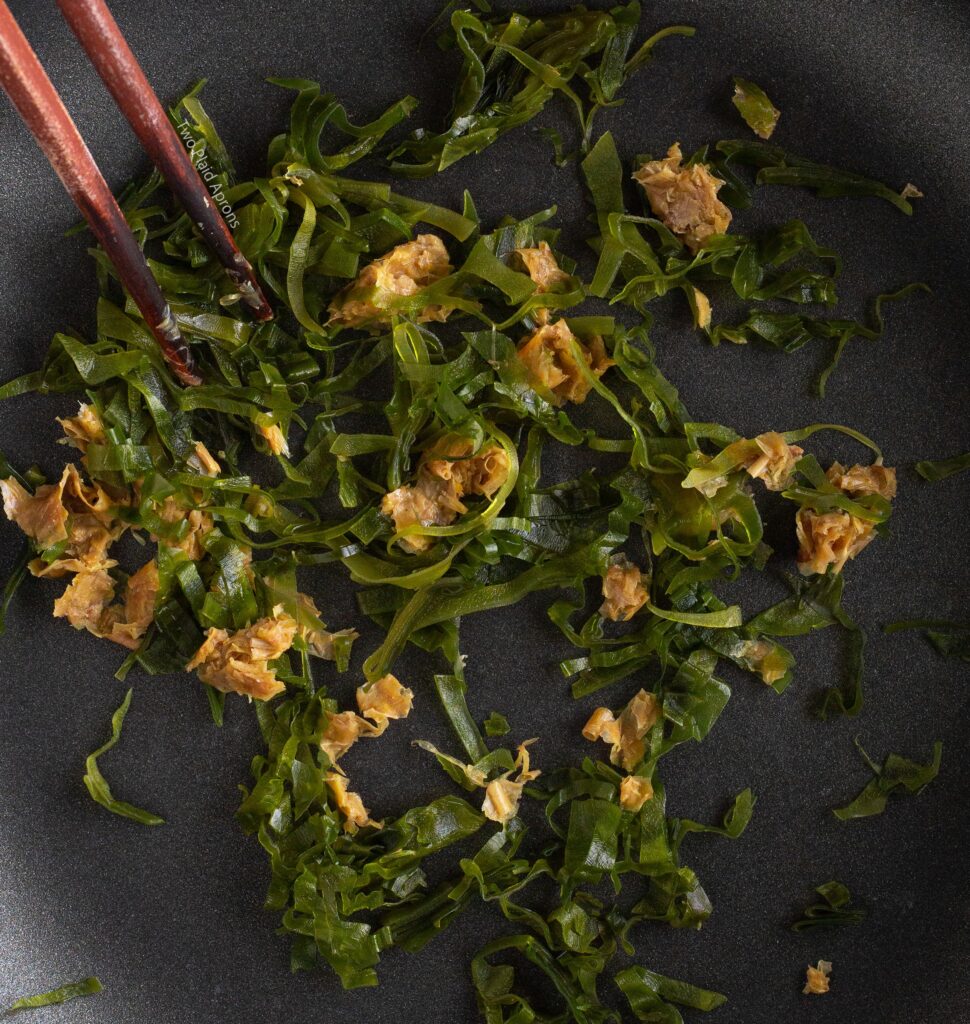









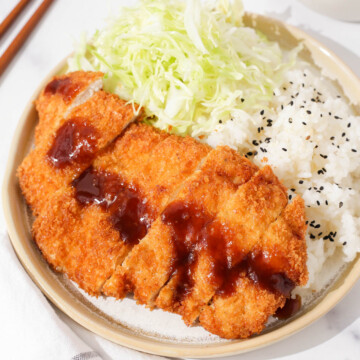

Comments
No Comments